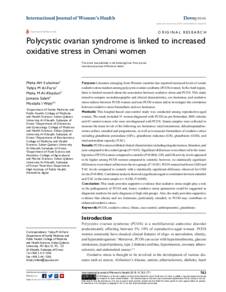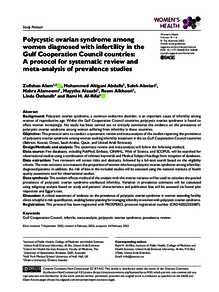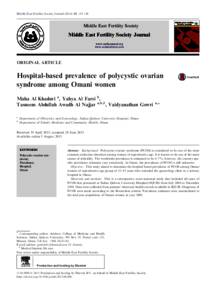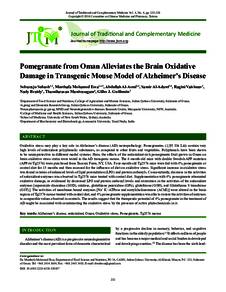وثيقة
Polycystic ovarian syndrome is linked to increased oxidative stress in Omani women.
المعرف
DOI: 10.2147/IJWH.S166461
المصدر
International Journal of Women's Health. v. 10, p. 763-771
المساهمون
الدولة
United Kingdom.
مكان النشر
London
الناشر
Dove Medical Press Ltd.
ميلادي
2018-01-01
اللغة
الأنجليزية
الملخص الإنجليزي
Purpose: Literature emerging from Western countries has reported increased levels of serum oxidative stress markers among polycystic ovarian syndrome (PCOS) women. In the Arab region, there is limited research about the association between oxidative stress and PCOS. This study aimed to compare sociodemographic and clinical characteristics, sex hormones, and oxidative stress indices between PCOS women and non-PCOS women and to investigate the correlation between oxidative stress biomarkers and sex hormones. Methods: This hospital-based case-control study was conducted among reproductive-aged women. The study included 51 women diagnosed with PCOS (as per Rotterdam 2003 criteria) and 45 control women who were not diagnosed with PCOS. Serum samples were collected to measure the mean levels of the following sex hormones: total testosterone, dehydroepiandros-terone sulfate, estradiol and progesterone, as well as to measure biomarkers of oxidative stress including glutathione peroxidase (GPx), glutathione reductase (GR), glutathione (GSH), and total antioxidant capacity (TAC). Results: PCOS women exhibited clinical characteristics including irregular menses, hirsutism, and acne compared to the control group (P≤0.05). Significant differences were observed in the waist-hip ratio of PCOS women compared to controls (P=0.004). GPx and GR activity levels appeared to be higher among PCOS women compared to controls; however, no statistically significant differences were observed between the two groups (P>0.05). PCOS women had lower GSH and TAC levels compared to controls with a statistically significant difference observed for GSH levels (P=0.006). Correlation analysis showed a significant negative correlation between estradiol and TAC in the total sample (r=-0.284, P=0.005). Conclusion: This study provides supportive evidence that oxidative stress might play a role in the pathogenesis of PCOS and, hence, oxidative stress parameters could be suggested as diagnostic markers for early diagnosis of high-risk groups. Also, the study provides supportive evidence that obesity and sex hormones, particularly estradiol, in PCOS may contribute to enhanced oxidative stress.
ISSN
1179-1411
قالب العنصر
مقالات الدوريات




